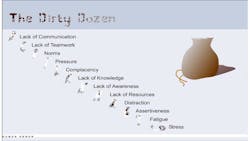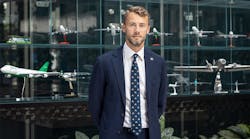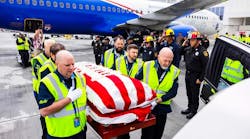Earlier this year (AMT, April ’14), I wrote about the history of a quarter of a century of maintenance and engineering human factors (M&E HF) training. Training is very important but it is not enough. Organizations now recognize that there is payback in the integration of M&E HF into the entire organization. This article is a natural unplanned Part II to the April training discussion. It reports on positive progress and on opportunities for improvement.
Author’s Perspective
When AMT Editor Ron Donner asked me to provide a 25-year evolution of M&E human factors, I quickly and humbly realized that he was asking the “right” person. I have been fortunate enough to be among a small group of individuals that not only strongly influenced M&E HF since 1988 but have sustained their efforts to the present time. Among the important partial list of long-time M&E HF professionals, mostly from the North America, include: James Reason (retired from University of Manchester), Bill Rankin (retired from Boeing), Colin Drury (retired from University of Buffalo), David Marx (Outcome Engenuity), the Honorable John Goglia (retired from US Airways and NTSB), Gordon Dupont (System Safety Services), and Jean Watson (FAA). Ms. Watson is especially important since she played a key role in obtaining FAA start-up and sustainment funding from 1988 to 2000. Many of the concepts described herein may be attributable to one of the persons listed above.
Here are six interventions that have influenced the history of M&E HF. They include:
- Training: Since the April ’14 AMT covers training, there are few details here. Some of the initial programs tried to focus on the organization, as suggested by James Taylor (retired from University of Southern California). However, focus on individual human strength and weakness became the norm. Regardless of the specific approach, training helped “human factors” become a household word. HF training evolved from classes filled with only mechanics and engineers to eventually include nearly everyone in the maintenance organization. The successful training expanded and was adopted throughout the world. In most countries human factors training is now mandated. Many U.S. maintenance organizations adopt HF training because of the recognized cost and safety impact.
- The HF Models: We cannot talk about a 25-year history of M&E HF without mentioning at least three of the most popular learning aides, all evolved in the mid-'90s. Professor James Reason created the Swiss cheese model, comparing aviation maintenance organizations, to a stack of sliced cheese. When the holes of the pile aligned it represented a situation where there were insufficient defenses (solid cheese) to stop the occurrence. Gordon Dupont introduced the “Dirty Dozen,” a listing of 12 conditions that contribute to human error. I worked with Dr. Mike Maddox to create the PEAR, which said that HF attention/intervention must be focused on People, Environment, Actions, and Resources. (See Figure 1). The Swiss cheese, the Dirty Dozen, and PEAR remain as timeless aids to help address maintenance human factors issues.
- Involving the Worker: The early trainers came from the ranks of academia. They were psychologists, educators, degreed engineers, etc. It became very clear that trainers benefited from maintenance field experience. Thus, maintenance personnel were extremely well suited to lead/facilitate the human factors programs. John Goglia emerged from the ranks of organized labor leadership at US Air (now US Airways). He was instrumental in leading the rank and file maintenance personnel to actively accept and participate in many HF endeavors. Of course, the Honorable Mr. Goglia eventually became the first A&P mechanic to serve as an NTSB board (Thank you President Clinton). Goglia pushed for attention to M&E HF at every opportunity, helping him to earn a friendly title as a Godfather of M&E HF. He impacted all of maintenance HF across the globe and continues to foster that goal.
- HF Focus on Event Reporting: In the early ‘90s the Boeing Company and its industry partners, under the leadership of a Boeing engineer named David Marx, created a system to investigate the contributing factors to maintenance-caused events. I participated in the early Boeing meetings as the system evolved. Many of the early, and very long deliberations, resulted in the success of the program that eventually became the Maintenance Error Decision Aid (MEDA). A key decision was to create a locally manageable system that was not dependent on industry data sharing. This permitted companies to proceed quickly, without associated complexity of government, lawyers, etc.
Dr. Bill Rankin eventually took MEDA to the level of industrywide acceptance that it has today. Dr. Rankin and his Boeing team eventually bundled MEDA with human factors and safety management systems training/implementation. Boeing has trained more than 850 maintenance organizations since the ‘90s. The tool remains relevant today as it provides data to the FAA Aviation Safety Action Program (ASAP) and the Aviation Safety Information Analysis and Sharing (ASIAS).
- Just Culture: The concept of “just culture” has roots back to the start of Boeing’s MEDA. The initial premise was that no worker comes to work to make an error. The error, therefore, is triggered by personal or organizational events that should be identified and corrected. Humans generally do not want to admit when they make an error. In most societies the reaction to a human error is to punish the human. The result is that workers will not report errors and organizations will not learn from the errors. Errors will be repeated. Voluntary reporting is dependent on “just culture.” I am not, for a minute, suggesting that our entire aviation industry has adopted just culture. In a recent survey of North American and European M&E organizations (See AMT September ’14), the combination of voluntary reporting and just culture remained as top M&E HF challenges.
FAA, EASA, and other National Aviation Authorities have been reasonably successful in making legal changes to protect workers who voluntarily report error. M&E organizations must evolve to minimize the scorn and impact on those who voluntarily report. As attitudes change, “old school” managers and regulators must also change or make way for those who recognize the value of voluntary reporting.
- Integration of M&E HF with Quality and Safety: As mentioned above, initial HF was all about training. The training was supplemented by a variety of positive industrial engineering influences from university R&D teams. For example, Dr. Colin Drury lead numerous projects related to topics like workplace design, communication during shift change, improving visual inspection, and much more. By the 2000s the HF impact was affecting the entire organization. M&E HF was becoming relevant. There was an increase in the number and managerial rank of those responsible for HF. Department and middle managers, including top executives were addressing HF issues. That meant there were increased instances of proper attention to procedures, tooling, scheduling, and general resourcing for the maintenance work force.
As M&E HF evolved there was increased attention to collecting and using cost data on human error. Some organizations have used the FAA and other return on investment models to justify investments on HF and other safety interventions. This approach has not fully matured but continues in a positive direction. Many maintenance organizations including Parts 145, 135, 121, 91, and others adopt M&E HF practices, without regulation. That is the very best indication of the recognized value of M&E HF.
Safety management systems (SMS) are an excellent way to help integrate M&E HF into the total organization. HF personnel should work with SMS counterparts to know the key performance indicators (KPI) that are impacted by M&E HF. At the same time there must be assurance that there is a two-way data flow. That will help ensure that many additional organization issues can possibly be addressed by M&E HF.
Are We There Yet?
No we are not there yet! The toughest thing to change is culture. Our industry has been on the M&E HF cultural change journey for nearly 30 years. We have made great progress. However, minimizing human error is a very difficult, honorable, and continuous goal. Suffice to say there is a lot of job security if you are in the business of minimizing human error.
Congratulations AMT
Finally, I congratulate AMT magazine on this 25-year anniversary issue. AMT and its sister aviation publications, Airport Business and Ground Support Worldwide, have provided an excellent means of communicating current information to many industry segments. I appreciate the opportunity of providing a personal view, influenced by my FAA position. Thank you, for reading and for commenting on my viewpoint.
Dr. William B. Johnson is the FAA Chief Scientific and Technical Advisor for Human Factors in Aircraft Maintenance Systems. His comments are based on nearly 50 years of combined experience as a pilot/mechanic, an airline engineering and MRO consultant, a professor, and an FAA scientific executive.
Figure 1: Models to promote understanding of M&E HF.
John Goglia, godfather figure for M&E HF



